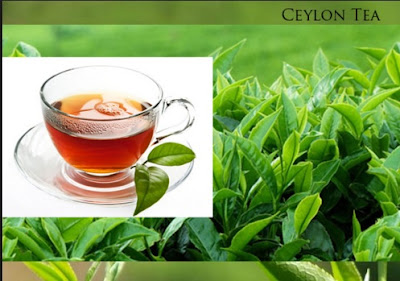Ceylon Tea
The History of Ceylon Tea
- 2737 BC - Tea was first discovered in China during the reign of Chinese Emperor Shen Nong.
- In 1824, British brought a tea plant from china to Ceylon.
- The botanical name for tea is " Camellia Sinensis " from China.
- In 1867, James Taylor ( Scottish by origin ) planted 19 acres of tea in the city of Kandy in Ceylon, at the Loolecondra Estate, Hewaheta as the first commercial tea plantation.
- The first public Colombo auction took place on 30th July 1883 under the guidance of the Ceylon Chamber of Commerce.
- Thomas Lipton, a Scottish businessman and millionaire came to Sri Lanka and made business deals with James Taylor. Lipton's company purchased Ceylon tea and distributed it to Europe and the USA. Tea became Sri Lanka's main commercial export crop and the entire local economy shifted to tea.
Agro - Climatic Tea Growing Regions of Sri Lanka
Area of Tea Planted in Sri Lanka
Elavation Planted (Ha) Share
High Grown 41,137 19%
Mid Grown 71,018 32%
Low Grown 109,814 49%
High Grown 41,137 19%
Mid Grown 71,018 32%
Low Grown 109,814 49%
Total 221,969 100%
NUWARA ELIYA - Delicately Fragrant
Nuwara Eliya Agro - climatic district is above 6200 ft. from sea level.
An oval shaped mountain valley with peak seasonal quality in January & February.
Teas manufactured in this region when prepared gives a light orange colour, delicate, fragrant and smooth on the palate ( discreetly perfumed aroma )
UDA PUSSELLAWA - Exquisitely Tangy
The Agro - climatic district is situated 4000- 5000 ft. above sea level.
Located on the edge of Uva and leading on to Nuwara Eliya is this mountain range.
During quality season it produces light, bright tea with rosy liquor.
It experiences two periods of superior quality - Jan./ Feb. & Aug./ Sept.
UVA - Exotically Aromatic
Uva Agro - climatic district is situated 3000 - 5000 ft. above sea level. Covers the Eastern slopes of Sri Lanka's central mountains.
Uva teas have a characteristic flavour and essentially powerful , sometimes heavily.
The peak seasonal quality appears in Aug./ Sept.
DIMBULA - Refreshingly Mellow
Dimbula district holds plantations from around 3500- 5000 ft. above sea level.
Covers an wide western slope of central highlands of tea planting districts of Sri Lanka.
The peak quality season is in February / March.
The area produces a range of teas from full bodied flavour to light, delicate and fragrant. When infused it gives a rich orange colour.
KANDY - Intensely full - bodied
Located in the mid country area of Sri Lanka.
Agro - climatic district situated from 2000 -4000 ft. above sea level.
Mid grown teas are known for its full bodied strong character. When prepared, it gives a deep red colour.
SABARAGAMUWA - Stylish and leafy
Grown in the southern part of the island range from sea level to an elevation of 2500 ft.
Situated in the southern grassland & through the world famous rain - forest of Sinharaja up to the southern foot hills of the central.
Broadly categories as low grown teas, famous for stylish leaf appearance and large practical size.
When infused, a deep red colour with smooth and mellow liquor.
RUHUNA - Distinctively Unique
Agro - climatic region famous for low grown tea is situated from sea level up to 1500 ft.
Located in the southern part of Sri Lanka at the edge of the Sinharaja rain - forest.
The unique features of Ruhuna tea are its blackness to the leaves and strength as well as character in the cup. When brewed, a dull red colour often sweet and sometimes rough.
Popular for its stylish leaf appearance.
A perfect cup for those who like their tea thick and sweet with milk.
"Ceylon Tea"- Major Grades
Competitive Advantages for Ceylon Tea
- Ceylon Teas are Hand picked
Ceylon teas are hand picked to ensure a better selection of green leaf for manufacture of tea. It is an expensive and labour intensive process, which greatly influences the final products quality.
- Ceylon Tea is Ethical
The Ceylon Tea Industry is well regulated with a unionized workplace that is governed by a collective labour agreement. Child labour is banned.
- Original Orthodox Tea
Sri Lanka still protects its conventional Orthodox tea manufacturing process that results in small batch, labour intensive production of awide variety of leaf style of grades that ensure the unique flavor and aroma. The vast majority of global production now uses the CTC ( Cut Tear & Curl ) process designed for efficiency.
- Producing Tea is a Passion
Growing and producing Ceylon tea is a tradition and a passion for almost 150 years. Each day about 1.5 million people all over Sri Lanka, from tea pluckers to tea producers, from tea tasters to tea packers, commit themselves to produce some of the finest black teas on earth. It is a way of life.
- Diversity
The 7 agro climatic regions namely Nuwar Eliya, Uva, Uda Pussellawa, Dimbula, Kandy, Ruhuna & Sabaragamuwa has given Ceylon Tea a unique advantage to produce teas of different flavor, aroma, strength and colour.
- Freshness
Teas are packaged in Sri Lanka in 2- 3 weeks from harvesting, thereby preserving the freshness and inherent aroma of the tea.
- The Cleanest tea in the world
Sri Lanka has implemented various measure to comply with environment related international conventions and agreements. Sri Lanka now offers the world " Ozone - Friendly " Ceylon Tea.
TEA & HEALTH
- Antioxidants
Tea is the 2 nd most popular drink after water. Research has shown that tea drinking could reduce the risk of heart disease. This is mainly due to reduction of fat and facilitation of proper functioning of the inner lining of the arteries.
- Tea protects against cancer
Research has also shown that tea polyphenols could help in reducing the initiation and progression of some cancers.
- Tea & Healthy Heart
Reduces cholesterol
Reduces blood clotting
- Tea & Oral health
Tea is a good source of Fluoride. Four to five cups provide approximately 50% of daily fluoride requirement. Regular intake of fluoride protects teeth from decay.
WHY WE SHOULD DRINK TEA
- Tea is a natural, healthy & safe beverage - free of fat, sugar, calories or sodium
- Tea is also a refreshing and reviving beverage which relieves stress.
- Tea release sleepiness and improves memory.
- It is an Age- Defying, Stress - releasing Remedy and improves longevity.
- Tea also good to release eye tiredness.
- Wash out with tea is an effective remedy to alleviate the symptoms of influenza or the common cold.









Very nice article! I am a big tea fan. I loved to read the interesting facts about tea and its evolution. I used to start my day with a cup of Premium Assam Tea
ReplyDeleteIt's a pleasure for me to hear that.Thankz for your comment.
ReplyDelete
ReplyDeleteThe rich history of Ceylon tea dates back to 1824 when the British introduced a tea plant from China to Sri Lanka. James Taylor, a Scottish planter, marked a pivotal moment in 1867 by establishing the first commercial tea plantation in Kandy. The inaugural Colombo auction in 1883, orchestrated by the Ceylon Chamber of Commerce, heralded a new era for the tea industry. Thomas Lipton's strategic business deals further propelled Ceylon tea to global prominence, shaping Sri Lanka's economic landscape. From Shen Nong's discovery to Lipton's legacy, each milestone intricately weaves the tapestry of Ceylon Tea enduring journey.